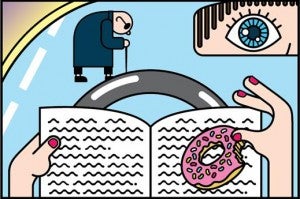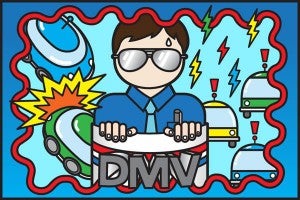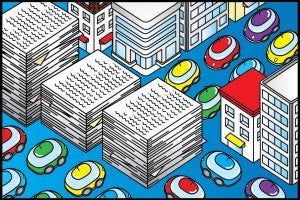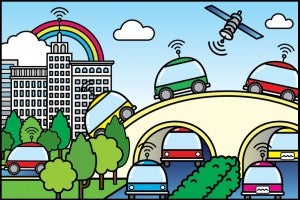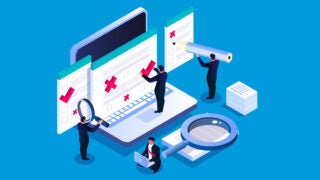Ask the experts: What’s next for driverless cars?
Contact: Andrew Good at (213) 740-8606 or gooda@usc.edu and Tanya Abrams at (213) 740-6973 or tanyaabr@usc.edu.
Driverless cars have the potential to change everything: transportation, health, the economy and the entire look of the urban landscape. Experts predict they could be ready for consumers in as little as five years, but big challenges lay ahead before they hit the road. The first injury-causing accident with a Google driverless car recently brought the issue of safety – including from cars with human drivers – to the fore.
Here’s a look ahead from USC experts on what’s next for driverless cars. To download the images in this release, click here.
Ethics: Programmers must decide whom to protect in wrecks
Who’s leading the way? California, Florida, Nevada and Michigan
On your way to work, you take your hands off the wheel and check your email. You don’t notice a biker who has swerved into the lane in front of you. The car’s AI is in control: will it swerve on to the curb, where it could hit passing pedestrians? Or does it swerve into traffic in the next lane?
These are the kinds of choices driverless vehicles need to make on the fly, said Jeffrey Miller, associate professor of engineering practices at the USC Viterbi School of Engineering. The car’s programmers will need to make ethical decisions about how the AI responds — decisions that will be guided based on federal and state regulations.
But none of the usual agencies, such as the U.S. Department of Transportation, have done much to prepare for the driverless car.
Where will change happen first?
Look to California, Florida, Nevada and Michigan to lead the way. The DMVs in these states have all taken first steps to develop markets for driverless vehicles. But the groundwork that’s been done isn’t enough, Miller said: far more on-the-road testing is needed.
Contact Jeffrey Miller: 213-740-7129 or jeffrey.miller@usc.edu.
Legal: DMV needs to draft safety and cybersecurity regulations
Who’s leading the way? California
Driverless cars pose multiple legal challenges, said Jonathan Handel, a professor at the USC Gould School of Law and former computer scientist who has testified before the California DMV on these issues.
“A key question is certification,” Handel said. “How will we know when driverless cars are safe? Google and the automakers say ‘trust us,’ but that’s not good enough: the auto industry’s safety record is terrible, and Google’s own record of compliance on a related issue, privacy, is tarnished as well.”
Other legal issues include privacy, cybersecurity, and economic disruption.
Where will change happen first?
Federal regulators like the National Highway Traffic Safety Administration are the best equipped to address these issues, Handel said. But so far they’ve punted the task to the California DMV, which is currently drafting safety certification regulations.
Contact Jonathan Handel: (323) 650-0060 or jh@jhandel.com.
Policy: Mass transit and insurers should brace for disruption
Who’s leading the way? Los Angeles
Driverless cars will be “an absolute game-changer” for transportation, said Lisa Schweitzer, associate professor at the USC Sol Price School of Public Policy.
Private companies will take on the early risks and figure out the logistics of a sustainable business model, Schweitzer said. But there would be trade-offs: a successful model would benefit those with discretionary income over those who rely primarily on public transportation.
This could devastate public transit agencies, which often lose money but employ lots of people. Driverless cars could end up putting a lot of bus drivers and other transit employees out of work, Schweitzer said.
Another big industry to be shaken up will be auto insurance, said Miller of USC Viterbi. Will the cost of insuring a car without a human driver be higher or lower? It depends on whether they’re really better at avoiding accidents or not, Miller points out — which is hard to tell, because there are no statistics yet on these vehicles.
Where will change happen first?
Los Angeles is going to be a prime market, Schweitzer said. It’s a sprawling city with limited public transportation options, whereas New York and D.C. have more established cab and metro systems.
Another hot market could be San Jose, Schweitzer said: “It’s full of rich people who love technology and the traffic is a joke.”
Contact Lisa Schweitzer: (213) 740-3866 or lschweit@usc.edu.
Infrastructure: Cities need to optimize their traffic networks
Who’s leading the way? Los Angeles
The more collaboration between infrastructure and cars, the better, Shahabi said. Sensors can collect traffic data and cars can control when the traffic light changes.
“The current navigation apps try to selfishly minimize the travel time for the individual driver,” said Cyrus Shahabi, professor of computer science and electrical engineering at the USC Viterbi School of Engineering and director of its Integrated Media Systems Center. “Future apps will take a global view of self-driven cars and Uber-type-rideshares so that the whole system flows better.”
Where will change happen first?
Los Angeles roads are already well equipped, with more than 10,000 traffic loop detectors installed, Shahabi said. “The people here are receptive to high-tech and IT companies are moving to LA.”
Contact Cyrus Shahabi: (213) 740-8162 or shahabi@usc.edu.

